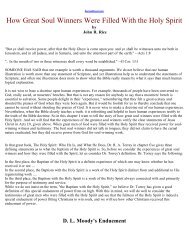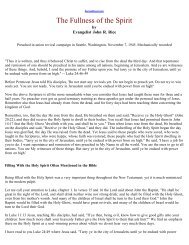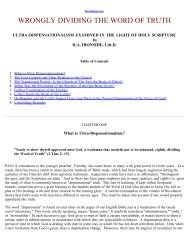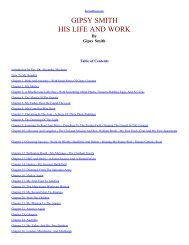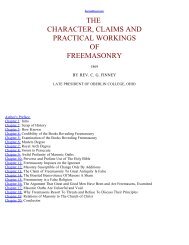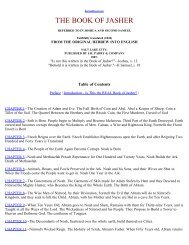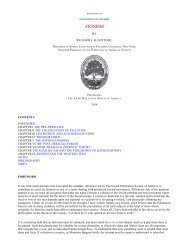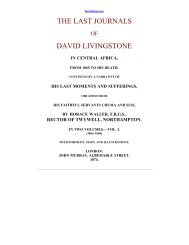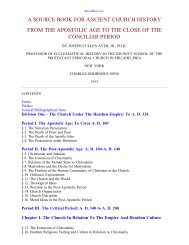Legends of Babylon and Egypt in Relation to Hebrew Tradition.pdf
Legends of Babylon and Egypt in Relation to Hebrew Tradition.pdf
Legends of Babylon and Egypt in Relation to Hebrew Tradition.pdf
You also want an ePaper? Increase the reach of your titles
YUMPU automatically turns print PDFs into web optimized ePapers that Google loves.
Here we have the def<strong>in</strong>ite statement that before Creation all the world was sea. And it is important <strong>to</strong> note that the<br />
primaeval water is not personified; the ord<strong>in</strong>ary Sumerian word for "sea" is employed, which the Semitic transla<strong>to</strong>r has<br />
faithfully rendered <strong>in</strong> his version <strong>of</strong> the text.[4] The reference <strong>to</strong> a channel <strong>in</strong> the sea, as the cause <strong>of</strong> Creation, seems<br />
at first sight a little obscure; but the word implies a "dra<strong>in</strong>" or "water-channel", not a current <strong>of</strong> the sea itself, <strong>and</strong> the<br />
reference may be expla<strong>in</strong>ed as suggested by the dra<strong>in</strong>age <strong>of</strong> a flood- area. No doubt the phrase was elaborated <strong>in</strong> the<br />
orig<strong>in</strong>al myth, <strong>and</strong> it is possible that what appears <strong>to</strong> be a second version <strong>of</strong> Creation later on <strong>in</strong> the text is really part<br />
<strong>of</strong> the more detailed narrative <strong>of</strong> the first myth. There the Crea<strong>to</strong>r himself is named. He is the Sumerian god Gilimma,<br />
<strong>and</strong> <strong>in</strong> the Semitic translation Marduk's name is substituted. To the follow<strong>in</strong>g couplet, which describes Gilimma's<br />
method <strong>of</strong> creation, is appended a further extract from a later portion <strong>of</strong> the text, there evidently displaced, giv<strong>in</strong>g<br />
additional details <strong>of</strong> the Crea<strong>to</strong>r's work:<br />
Gilimma bound reeds <strong>in</strong> the face <strong>of</strong> the waters, He formed soil <strong>and</strong> poured it out beside the reeds.[5] [He][6] filled <strong>in</strong> a<br />
dike by the side <strong>of</strong> the sea, [He . . .] a swamp, he formed a marsh. [. . .], he brought <strong>in</strong><strong>to</strong> existence, [Reeds he<br />
form]ed,[7] trees he created.<br />
[1] The composite nature <strong>of</strong> the text is discussed by Pr<strong>of</strong>essor Jastrow <strong>in</strong> his /<strong>Hebrew</strong> <strong>and</strong> <strong>Babylon</strong>ian <strong>Tradition</strong>s/, pp.<br />
89 ff.; <strong>and</strong> <strong>in</strong> his paper <strong>in</strong> the /Journ. Amer. Or. Soc./, Vol. XXXVI (1916), pp. 279 ff.; he has analysed it <strong>in</strong><strong>to</strong> two<br />
ma<strong>in</strong> versions, which he suggests orig<strong>in</strong>ated <strong>in</strong> Eridu <strong>and</strong> Nippur respectively. The evidence <strong>of</strong> the text does not appear<br />
<strong>to</strong> me <strong>to</strong> support the view that any reference <strong>to</strong> a watery chaos preced<strong>in</strong>g Creation must necessarily be <strong>of</strong> Semitic<br />
orig<strong>in</strong>. For the literature <strong>of</strong> the text (first published by P<strong>in</strong>ches, /Journ. Roy. Asiat. Soc./, Vol. XXIII, pp. 393 ff.), see<br />
/Sev. Tabl./, Vol. I, p. 130.<br />
[2] Obv., ll. 5-12.<br />
[3] Sum. /nig<strong>in</strong>-kur-kur-ra-ge/, Sem. /nap-har ma-ta-a-tu/, lit. "all l<strong>and</strong>s", i.e. Sumerian <strong>and</strong> <strong>Babylon</strong>ian expressions<br />
for "the world".<br />
[4] Sum. /a-ab-ba/, "sea", is here rendered by /tâmtum/, not by its personified equivalent Tiamat.<br />
[5] The suggestion has been made that /amu/, the word <strong>in</strong> the Semitic version here translated "reeds", should be<br />
connected with /ammatu/, the word used for "earth" or "dry l<strong>and</strong>" <strong>in</strong> the <strong>Babylon</strong>ian Creation Series, Tabl. I, l. 2, <strong>and</strong><br />
given some such mean<strong>in</strong>g as "expanse". The couplet is thus expla<strong>in</strong>ed <strong>to</strong> mean that the god made an expanse on the<br />
face <strong>of</strong> the waters, <strong>and</strong> then poured out dust "on the expanse". But the Semitic version <strong>in</strong> l. 18 reads /itti ami/, "beside<br />
the /a./", not /<strong>in</strong>a ami/, "on the /a./"; <strong>and</strong> <strong>in</strong> any case there does not seem much significance <strong>in</strong> the act <strong>of</strong> pour<strong>in</strong>g out<br />
specially created dust on or beside l<strong>and</strong> already formed. The Sumerian word translated by /amu/ is written /gi-dir/, with<br />
the element /gi/, "reed", <strong>in</strong> l. 17, <strong>and</strong> though <strong>in</strong> the follow<strong>in</strong>g l<strong>in</strong>e it is written under its variant form /a-dir/ without /gi/,<br />
the equation /gi-a-dir/ = /amu/ is elsewhere attested (cf. Delitzsch, /H<strong>and</strong>wörterbuch/, p. 77). In favour <strong>of</strong> regard<strong>in</strong>g<br />
/amu/ as some sort <strong>of</strong> reed, here used collectively, it may be po<strong>in</strong>ted out that the Sumerian verb <strong>in</strong> l. 17 is /kešda/, "<strong>to</strong><br />
b<strong>in</strong>d", accurately rendered by /rakašu/ <strong>in</strong> the Semitic version. Assum<strong>in</strong>g that l. 34 belongs <strong>to</strong> the same account, the<br />
creation <strong>of</strong> reeds <strong>in</strong> general beside trees, after dry l<strong>and</strong> is formed, would not <strong>of</strong> course be at variance with the god's use<br />
<strong>of</strong> some sort <strong>of</strong> reed <strong>in</strong> his first act <strong>of</strong> creation. He creates the reed-bundles, as he creates the soil, both <strong>of</strong> which go <strong>to</strong><br />
form the first dike; the reed-beds, like the other vegetation, spr<strong>in</strong>g up from the ground when it appears.<br />
[6] The Semitic version here reads "the lord Marduk"; the correspond<strong>in</strong>g name <strong>in</strong> the Sumerian text is not preserved.<br />
[7] The l<strong>in</strong>e is res<strong>to</strong>red from l. 2 o the obverse <strong>of</strong> the text.<br />
Here the Sumerian Crea<strong>to</strong>r is pictured as form<strong>in</strong>g dry l<strong>and</strong> from the primaeval water <strong>in</strong> much the same way as the early<br />
cultiva<strong>to</strong>r <strong>in</strong> the Euphrates Valley procured the rich fields for his crops. The existence <strong>of</strong> the earth is here not really<br />
presupposed. All the world was sea until the god created l<strong>and</strong> out <strong>of</strong> the waters by the only practical method that was<br />
possible <strong>in</strong> Mesopotamia.<br />
In another Sumerian myth, which has been recovered on one <strong>of</strong> the early tablets from Nippur, we have a rather<br />
different picture <strong>of</strong> beg<strong>in</strong>n<strong>in</strong>gs. For there, though water is the source <strong>of</strong> life, the existence <strong>of</strong> the l<strong>and</strong> is presupposed.<br />
But it is bare <strong>and</strong> desolate, as <strong>in</strong> the Mesopotamian season <strong>of</strong> "low water". The underly<strong>in</strong>g idea is suggestive <strong>of</strong> a



